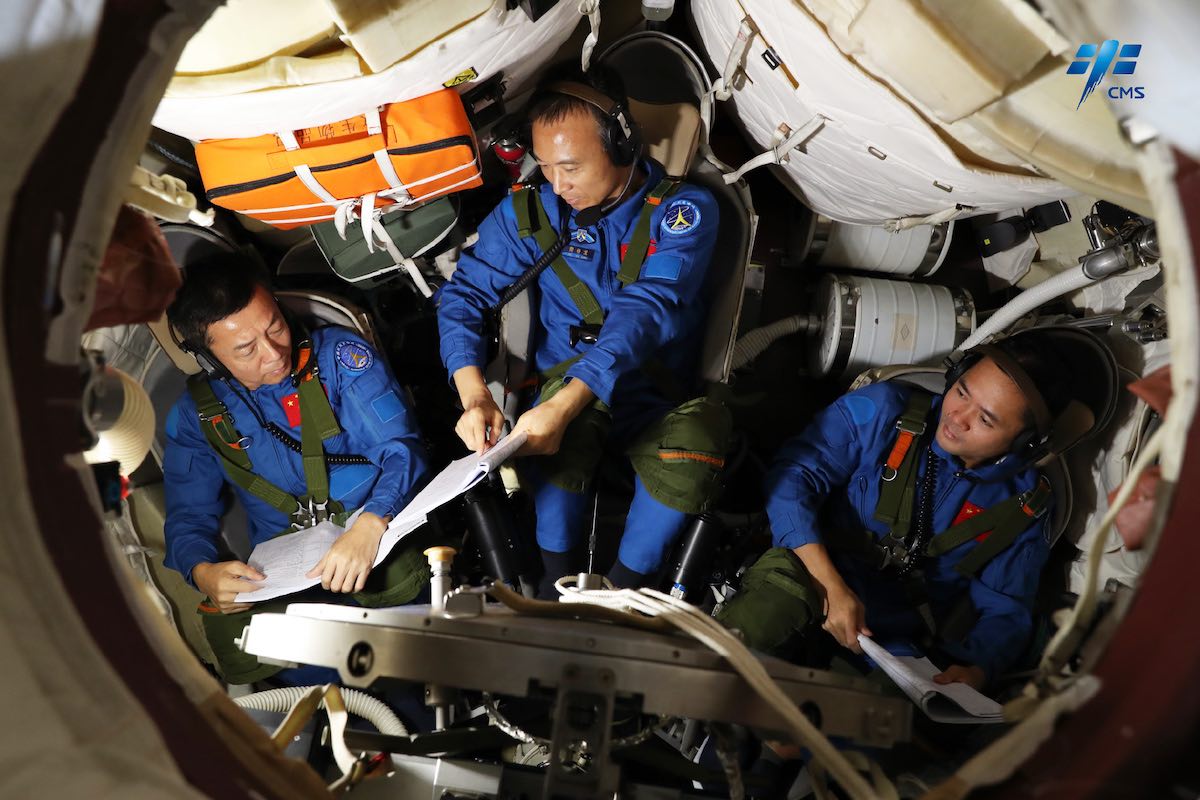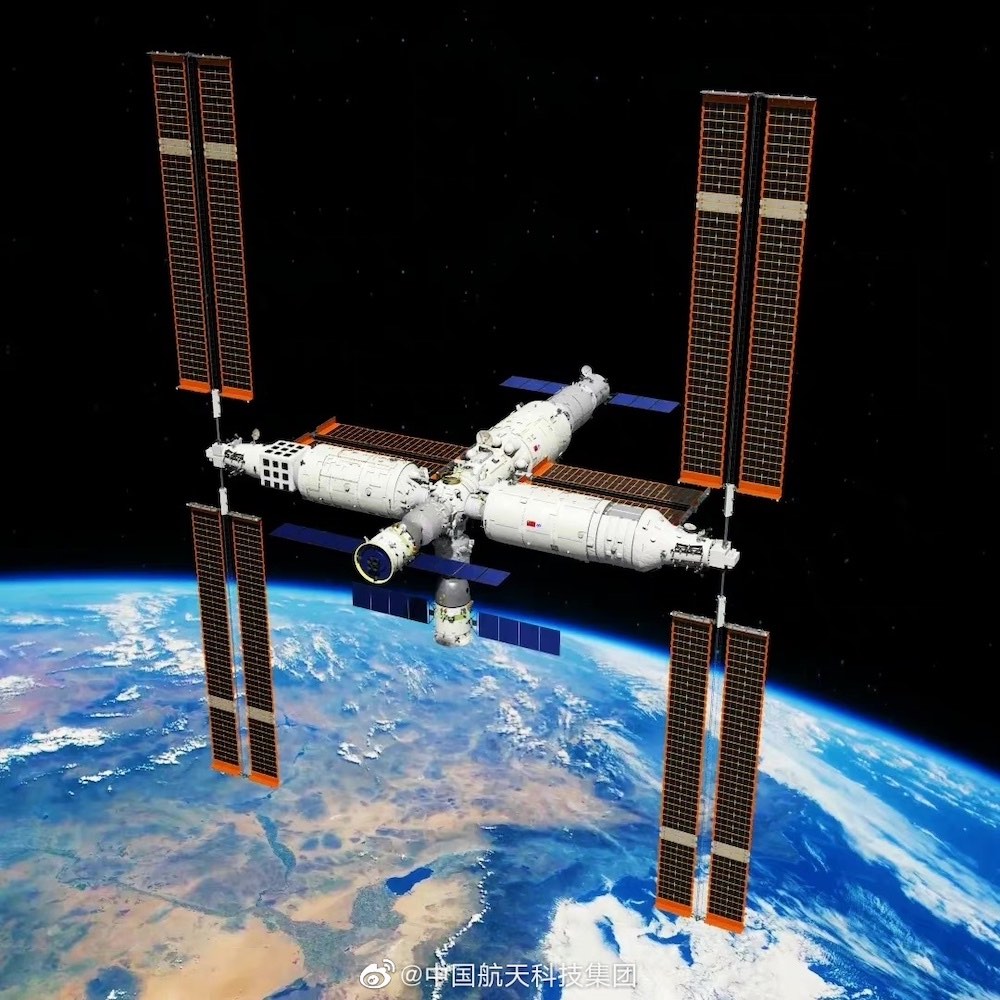
Three Chinese astronauts will strap into a Shenzhou spacecraft and rocket into orbit Tuesday in pursuit of China’s Tiangong space station on a six-month mission to transition the space lab from construction into an operational phase.
Veteran commander Fei Junlong will be joined by rookie astronauts Deng Qingming and Zhang Lu for liftoff at 10:08 a.m. EST (1508 GMT) from the Jiuquan launch base, a remote military-run spaceport in the Gobi Desert of northwestern China.
Freezing temperatures are forecast for the launch, which is scheduled for 11:08 p.m. Beijing time, when the Earth’s rotation brings the Jiuquan launch site underneath the orbital plane of the Tiangong space station. None of China’s astronaut missions have launched so late in the year. China’s nine crew launches since the country’s first human spaceflight in 2003 have blasted off in June, September, or October.
The China Manned Space Agency said ground equipment at the launch site was “completely updated and modified” to better withstand the cold temperatures. Engineers have developed procedures to ensure propellant tanks remain at proper temperatures during the countdown, and added insulation to specific sections of the rocket.
Chinese officials revealed the identities of the astronauts on the Shenzhou 15 mission Monday. In contrast to the U.S. and Russian space programs, China typically keeps its crew assignments secret until the day before launch.
Fei, 57, commanded the Shenzhou 6 mission in 2005, China’s second crewed flight to low Earth orbit. He spent nearly five days in orbit, and is ready to launch into space again more than 17 years later.
“Today, I am very proud and excited to be able to go to space again for my country,” Fei said in brief remarks to news media gathered at the Jiuquan launch site. “Especially when we are about to enter our own Chinese space station, I am deeply proud and proud of our great motherland.”

“The Shenzhou 15 mission is not only the last of the construction period of China’s space station, but also the beginning of the next new stage,” Fei said. “During the half-year flight, we will conduct more on-orbit tests, and the operation, maintenance and repair of equipment.”
Chinese officials said the Shenzhou 15 astronauts will head outside the Tiangong space station for three or four spacewalks to complete tasks that Fei described as “more arduous” and “more complicated” than previous Chinese spacewalks.
“Therefore, we have carried out a lot of targeted training on the ground,” said Fei, a major general in the Chinese Air Force. “Through the training, we also have enough confidence to complete this key link between the past and the future.”
Fei and his crewmate Deng Qingming, a 56-year-old former Chinese Air Force fighter pilot, were selected in China’s first class of astronauts in 1998. But Deng had to wait a quarter-century for his first flight to space.
“We deeply know that it is thousands of aerospace science and technology workers who support us to fly,” Deng said. “Here, I would like to pay tribute to all Chinese astronauts and thank you for your hard work. We will definitely complete this mission successfully.”
Zhang, 46, is another former fighter pilot in the Chinese Air Force. He joined China’s astronaut corps in 2010.
“I am very much looking forward to experiencing the wonderful feeling brought by weightlessness, very much looking forward to building our own space home as soon as possible with my own hands, and very much looking forward to presenting the beauty of space in my eyes to all my friends and family members,” Zhang said.

The three-man Shenzhou 15 crew will replace the Shenzhou 14 astronauts, who launched June 5 and are due to return to Earth next week. Shenzhou 14 commander Chen Dong, astronaut Liu Yang, and crew member Cai Xuzhe launched June 5 and to take the place of the Shenzhou 13 mission that ended in April.
This time, the crew handover between the Shenzhou 14 and 15 astronauts will occur aboard the Tiangong space station. The arrival of Shenzhou 15 will temporarily raise the station’s crew size to six.
“Currently the space station combination is in stable status, with all equipment functioning well, ready for the rendezvous and docking, and the crew handover,” said Ji Qiming, assistant to the director of the China Manned Space Agency. “All pre-launch preparations are in order.”
During their six-month mission, the Shenzhou 14 astronauts saw the arrival of the second and third major elements of the Tiangong space station. China launched the Wentian science lab July 24, then the Mengtian module Oct. 31. The modules initially docked with the forward port of the station’s Tianhe core module, then were moved to radial ports using a robotic arm to give the Tiangong outpost a distinctive “T” shape.
China launched the unpiloted Tianzhou 5 cargo ship to the space station Nov. 12. The Shenzhou 14 astronauts also completed three spacewalks to further outfit the space station.
“They witnessed many historical moments of China’s manned spaceflights,” Ji said, speaking about the Shenzhou 14 crew.

Chinese ground teams rolled the 191-foot-tall (58-meter) Long March 2F rocket to the launch pad Nov. 21 in preparation for the Shenzhou 15 mission. Gantry arms enclosed the launcher as technicians completed final processing and inspections on the rocket. Loading of several hundred tons of toxic hydrazine and nitrogen tetroxide propellants into the rocket began Monday.
The three astronauts will climb into the Shenzhou 15 crew module about two to three hours before liftoff.
A core stage engine and four strap-on boosters will ignite to generate 1.4 million pounds of thrust, driving the rocket and crew eastward from Jiuquan in pursuit of the Chinese space station. The Long March 2F will consume thousands of gallons of toxic, corrosive propellants to accelerate the 8.5-ton Shenzhou 15 spaceship into orbit.
The second stage of the rocket will deploy the crew craft about 10 minutes into the mission. Moments later, Shenzhou 15 is programmed to unfurl its solar panels to begin producing its own electricity.
The spacecraft will fire thrusters to fine-tune its approach to the Chinese space station, culminating in an automated docking at the Tianhe core module later Tuesday. The astronauts will open hatches and float into the Tianhe core module to begin their work.
“According to the plan, the Shenzhou 15 spacecraft will execute … fast autonomous rendezvous and docking procedures. The spacecraft will dock with the forward port of the Tianhe core module to form a three-module and three-ship combination, which is, by far, the largest configuration of China’s space station with a total mass of near 100 (metric) tons,” Ji said.
Email the author.
Follow Stephen Clark on Twitter: @StephenClark1.
from Spaceflight Now https://ift.tt/QpNb3KL
via World Space Info







0 comments:
Post a Comment